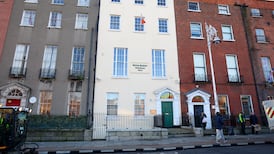Driving from Dublin out to Howth recently, on the coast road, I had my head forcibly turned by a vision unfolding on the top of a large tree in St Anne’s Park.
The tree was being attacked by a man with a chainsaw. But rather than firewood, he was turning it into a sculpted wildlife colony. Already, the shapes of a brent goose, several owls, a sparrowhawk, and a badger had emerged from the raw material – all rendered in a loving detail somewhat at odds with the machine that was carving them.
The lumberjack Michelangelo turned out to be Tommy Craggs, from Durham in the north of England, who specialises in making art from dying or condemned trees, as was the case here.
A Monterey cypress, no less, this one had the tendency of its kind, when mature, to shed branches.
That would have been perfectly acceptable in a Californian forest, but it might have been bad news for Clontarf pedestrians and drivers.
Landmark
So, after a couple of near-misses, the city council had the dangerous bits removed. Then, to ease the community’s grief at the loss of a loved landmark, it called in Craggs to turn what remained of the tree into beauty.
Working on a scaffolded platform, with a range of saws, he was a source of intense interest to passers-by in recent days, until the job was suspended.
His plan, eventually, is for three tiers of wildlife – birds at the top, earth-bound creatures in the middle, and marine life lower down. Unlike the Monterey cypress, these will all be local species – many to be found in the great wildlife sanctuary just across the road, Bull Island.
But for various reasons, it’s a two-part project. The artist packed up his chainsaws this week and applied wood preserver to his work-in-progress, which will now remain unfinished until he returns in spring.
Tree sculptures aside, that part of Dublin has form in adapting nature to human ends. Nearby, for example, in a wooded corner of St Anne’s, is a BMX bike park, sculpted from the earth. I wouldn’t call it a work of art, exactly. But my 15-year-old, BMX-owning son would – he thinks it’s a masterpiece.
Then of course there’s the aforementioned Bull Island – itself the result of an extraordinary collaboration between nature and humanity. The artist in that case, if I might describe him as such, was a man who had already achieved a certain infamy elsewhere – Capt William Bligh.
In 1801, more than a decade after his difficulties on the Bounty, Bligh was given a less exciting naval commission– to carry out a survey of Dublin Bay, which was notoriously prone to silting and had numerous shipwrecks to prove it.
The problem has not been solved by the 1715 South Bull Wall. So in the process of finding a permanent answer, Bligh identified the importance of a sand spit on the north of the bay, and prescribed a new wall – an effect of which was to speed the pile-up of sand.
Nearly two centuries later, Bull Island is now five kilometres long and about 800 metres wide.
It has one of Dublin’s finest beaches on its seaward side, a salt marsh and wildlife sanctuary on the leeward, and two golf courses in between.
The island is a Unesco biosphere – unusual as such in being so close to the centre of a capital city. And as well as being a haven for many plants and animals, including orchids and migrant geese from Canada, it attracts all human life – or nearly – too.
Between 1914-18, it was commandeered by the British army, for trench-warfare practice. Since then, returned to civilian use, it has become a recreational treasure. Golfers aside, the island attracts walkers, swimmers, runners, triathletes, kite-surfers, and anglers. The flat wide beach, with its compacted sand, is even popular with learner drivers.
It also used to be home to a hare population, although that species seems to be in retreat now even there (and everywhere except Dublin Airport, a subject to which I must return).
And it has been the subject of some hare-brained schemes too – including plans to turn it into a holiday camp or, worse, a dump. Mercifully, sanity prevailed. The island has instead continued to grow in usefulness, just as it continues to grow physically.
As for Captain Bligh’s role, however incidental, it has turned into more of a bounty than his infamous ship ever was.
@FrankmcnallyIT










